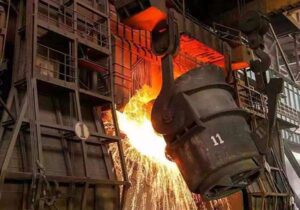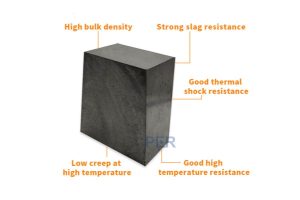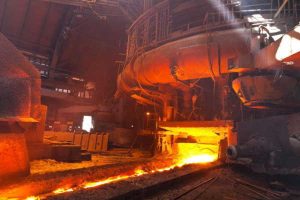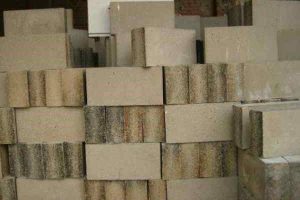With the emergence of oxygen-blown converters and continuous casting, ladle-lining clay brick (even high alumina brick) is no longer applicable.
In the ladle lining high alumina and alkalization of the early stage, not burned aluminum magnesium brick and later the successful development and application of aluminum magnesium carbon brick, occupy quite a long time.
Even in pure aluminum-magnesium castable overall lining promotion period, aluminum magnesium carbon brick is still not lost as an important material for ladle lining.
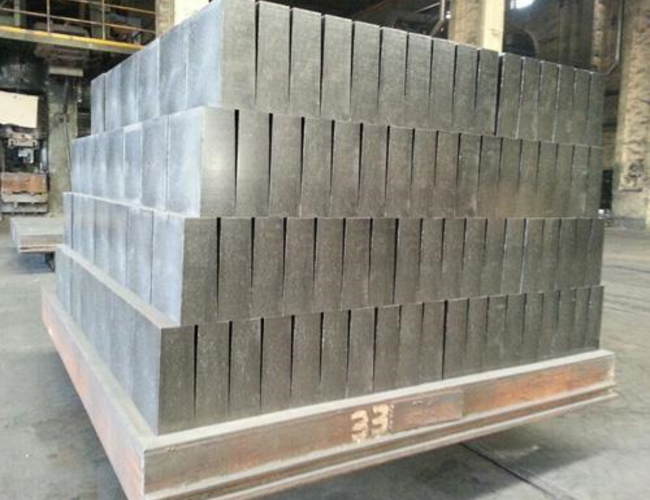
Steel Ladle Does Not Burn Aluminum Magnesium Brick
The ladle does not burn aluminum and magnesium brick is made of high alumina bauxite clinker and magnesia sand as raw material, ladle lining with non-burning refractory products. With the increase in steel temperature and residence time in the ladle, clay brick lining erosion is serious.
In the use of high alumina brick at the same time, aluminum magnesium not burned brick can replace the clay brick and low-grade high alumina brick. This does not burn aluminum magnesium brick to special or a level of high alumina bauxite and a level of brick making magnesium sand as raw materials, water glass as a binding agent, according to a certain proportion of ingredients.
Magnesia sand fine powder and bauxite fine powder together mixed fine grinding, by mixing and brick press molding, drying to 200 ℃, and after quality, inspection qualified that is the finished product.
The typical physical and chemical properties of this brick: Al2O372%, MgO9.8%, bulk density of 2.63 ~ 2.85g/cm3, apparent porosity of 20% ~ 21%, room temperature compressive strength of 52.2 ~ 117MPa, load softening temperature of 1420 ℃.
Due to the MgO addition in the ingredients according to all the matrix has SP composition calculation, not burned aluminum magnesium brick has good thermal shock resistance and resistance to alkaline slag erosion performance.
However, due to the introduction of low melting point substances such as Na2O in water glass bonding agents, its high-temperature strength and load softening temperature are low.
In addition, due to the thermal conductivity of this brick to clay brick, resulting in the package being easy to knot cold steel and sticky slag, in use should take preheating and insulation measures.
In a broad sense, alumina, magnesium oxide, and carbon as the main components of the refractory materials can be collectively referred to as aluminum-magnesium carbon refractory materials.
Aluminum-magnesium carbon brick is a high alumina clinker (or corundum), magnesia sand (or magnesia-alumina spinel SP) and graphite as the main raw material, with asphalt or resin combined with the non-burning fixed refractory products.
Aluminum-magnesium carbon refractory products according to the different content of alumina or magnesium oxide can be divided into two categories: a class of alumina is the main component of aluminum-magnesium carbon bricks, commonly used AMC or LMC said. Another category is magnesium oxide is the main component of the magnesium aluminum carbon brick, commonly used as MAC or MLC said.
With the emergence of continuous casting ladle and furnace refining ladle, ladle in the steel temperature increase and residence time extension, the original ladle lining clay brick, high alumina brick, and aluminum and magnesium does not burn brick has been unable to meet the use of requirements.
Aluminum-magnesium carbon brick is not burned brick developed in the late 1980s. To improve the use of small and medium capacity ladle with water glass combined with non-fired aluminum and magnesium brick performance added graphite, service life has improved, but soon replaced by resin combined with aluminum and magnesium carbon brick.
Aluminum-magnesium Carbon Brick Characteristics
Aluminum-magnesium carbon brick is in the magnesium carbon brick and aluminum carbon brick and other bricks containing carbon, based on the absorption of the characteristics of aluminum-magnesium refractory materials developed, both carbon refractories and aluminum-magnesium refractory advantages. This carbon composite non-combustible brick, not only has excellent chemical and thermodynamic stability but also has excellent thermal and mechanical properties.
(1) High resistance to steel and slag penetration. Due to the reaction between MgO fines and alumina fines within the matrix during high-temperature use, the in-situ generation of SP is accompanied by controlled volume expansion, which facilitates the densification of the brick and prevents the penetration of steel and slag from the working surface of the brick and the masonry joints.
(2) Excellent anti-slag erosion performance. In addition to the anti-erosion effect of graphite, the use of the process of in situ generations of SP can absorb FeO in the slag and the formation of solid melt; Al2O3 and CaO reaction in the slag to form a high melting point CaO-Al2O3 system compounds, play a role in blocking brick pores and increase the viscosity of the melt, to inhibit slag penetration and anti-slag erosion purposes.
(3) High mechanical strength. Compared with MgO-C brick and Al2O3-C brick, aluminum magnesium carbon brick graphite added less, generally in 6% ~ 12%, so it has a large bulk density, low porosity, and high strength characteristics.
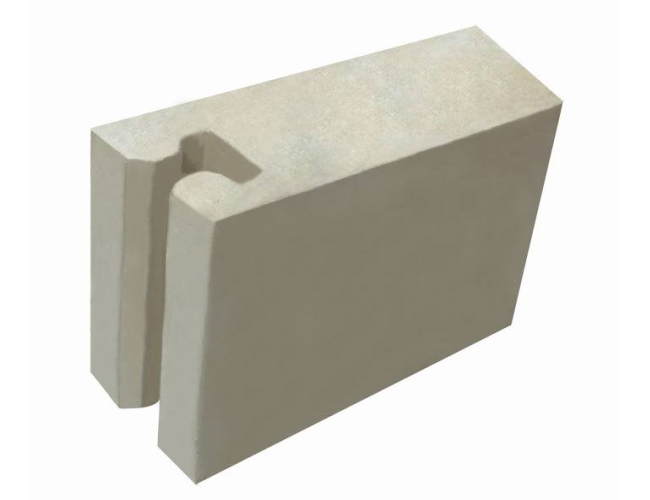
The Production Process of Al-Mg Carbon Brick
The production process of aluminum-magnesium carbon brick is the same as MgO-C brick. Adopt measures to make the mixing uniform and improve the molding pressure is the process to ensure the excellent performance of aluminum and magnesium carbon brick using the basic conditions. The purity of the main raw material of Al-Mg-C brick has a large fluctuation range.
The raw material containing alumina can be used as first-class high alumina bauxite clinker, special high alumina bauxite clinker, brown corundum, sintered corundum, and electrofused corundum. Magnesium oxide raw materials can be used in sintered magnesia sand and electrofusion magnesia sand. Carbon raw materials are mainly natural flake graphite. Binding agent commonly used synthetic sound aldehyde resin. Anti-oxidant using SiC and Al powder.
Alumina-containing raw materials generally account for 80% to 85% of the total components of aluminum and magnesium carbon brick ingredients, the ingredients can be granular and fine powder to join.
Many kinds of alumina-containing raw materials, but high alumina bauxite contains high SiO2 and other impurities, which can reduce the slag resistance of the brick.
Sintered corundum and electrofused corundum comparison, the former crystalline fine, more grain boundaries, with its manufacturing of aluminum and magnesium carbon brick slag resistance than the same conditions with electrofused corundum manufacturing of aluminum and magnesium carbon brick.
Contains magnesium oxide raw materials, compared with sintered magnesite sand, electrofused magnesite sand grain size coarse, bulk density, and high MgO content, so the resistance to slag erosion ability.
In the non-fired aluminum magnesia carbon brick ingredients generally add electric fused magnesia sand, mainly in the form of fine powder to add, the amount added is generally controlled within 15%.
The appropriate amount of magnesia fine powder added, the use of the process in situ SP generated volume expansion effect is conducive to plugging the brick pore.
But magnesia fine powder added too much, too much SP generation causes excessive volume expansion, brick internal will produce excessive thermal stress and cracks, reducing the strength of the brick.
The carbon raw material of aluminum-magnesium carbon brick is generally based on natural scale graphite. To avoid the actual use of graphite in the low-temperature oxidation and due to graphite thermal conductivity caused by the ladle in the steel temperature drop being too large, the amount of graphite added to the general control was within 10%.
Aluminum and magnesium carbon bricks use the same binding agent and other carbon refractory materials, mainly synthetic phenolic resin, the amount of its addition depends on the molding equipment, generally in 4% to 5%.
Resin bonded aluminum-magnesium carbon bricks, not only in the electric furnace continuous casting ladle and converter continuous casting ladle molten pool to obtain applications, and in the large capacity brick refining ladle molten pool occupies a considerable proportion.
PER refractory bricks have professional production and export experience in China, we will be your best choice to buy high-quality and low price fire bricks. You can contact us to visit our refractory manufacturing plant or send us an email for a price list. Welcome to learn more about PER refractory bricks in China.

